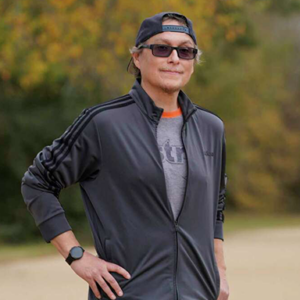
Photo courtesy of Melissa Phillip / Houston Chronicle
Gene Velasquez, 55, collapsed while running at Memorial Park in June of last year when he suffered a heart attack and was in cardiac arrest. Mr. Velasquez spent the following five days in a coma. A good Samaritan gave him CPR and put him in an ambulance, which rushed him to the hospital. Upon arriving at the hospital, he was met by Professor and Chair of the Department of Emergency Medicine at McGovern Medical School and attending physician at Memorial Hermann Dr. Bentley Bobrow, MD, FACEP.
“Gene was unconscious and not able to breathe on his own. We immediately placed him in therapeutic hypothermia treatment to prevent further damage from a lack of blood flow to the brain. His heart stopped and he was clinically dead. The odds of someone surviving are very, very low. Probably around 7% of the time, ” Bobrow said. “We scanned his arteries to find a blocked blood vessel. We had to fix Gene and his heart and support his brain while all of this was going on.”
Velasquez’s cardiac arrest stemmed from a heart attack, events that can be mistaken as the same. With a heart attack, a victim is conscious and will need treatment within 60 minutes. For cardiac arrest, death can follow in five to 10 minutes without CPR and defibrillation. Miraculously, paramedics on-site during Gene’s heart attack were contacted by witnesses and performed bystander CPR on a collapsed Gene until an ambulance arrived.
“In cardiac arrest scenarios, you literally have a matter of minutes. If no one does bystander CPR, it’s highly unlikely someone will survive something like this, ” continued Bobrow.
“Words can not express what I would want to say to them. They saved my life,” remarked Gene Velasquez. “Excluding the circumstances, I would say my experience during recovery was amazing. The people were friendly, the staff kept me well informed, the doctors were extremely caring, and anything I needed was there for my recovery. I wasn’t aware of all the additional resources that are available to help others in a similar situation like mine. Resources like the Texas’ Cardiac Arrest Registry to Enhance Survival Program, helps others to be better prepared incase they might have to perform life saving CPR on someone when timing is critical.”
Since making a successful recovery, Gene visited Memorial Park weekly in hopes his mystery Samaritan would recognize him. After months of searching and with help of a published story by KHOU-11 the mystery Samaritan was able to be found. Initially thought to be the acts of one individual, turned out to be several people that stopped to help the day of Gene’s heart attack.
Sargent David Gonzalez with the University of St. Thomas Police Department, Jack Perini, Eric McClendon and Mike Gonzalez were four of seven witnesses that took turns performing CPR awaiting for an ambulance arrival after calling 911. Without any prior knowledge about Mr. Velasquez, the four men wondered if the man they helped was ok.
“When the story aired, I was showing people. I was so glad, it was such a big relief,” declared Eric McClendon.
“We had no identification information for Gene at the time, he was a John Doe,” Gonzalez said. “I ended up collecting contact information for everyone else there. So when the broadcast aired, it was an overwhelming feeling to know the person we helped out was alive.”
Eternally grateful, Gene stays in close contact with the men that saved his life.
“It makes me feel better now that I know what happened,” assured Gene Velasquez “There’s good people out there still and I’m glad I was able to meet these good people.”
Gene Velasquez story was recently featured in the Houston Chronicle’s “ReNew” health section providing a more in-depth overview of this phenomenal tale.
